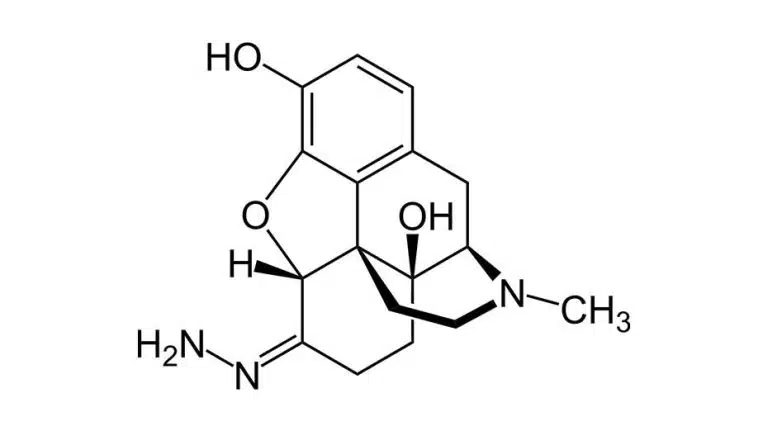Understanding Oxymorphazone & Irreversible Opioid Agonists
- What Is Oxymorphazone?
- Effects Of Irreversible Binding
- What Are Irreversible Antagonists?
- Naloxazone & Naltrexazone
- Dangers Of Irreversible Agonists

Opioid analgesics (also called opiates) are drugs that ease pain by binding to opioid receptors throughout your nervous system. They mimic the effects of your body’s endogenous opioid peptides. These effects may include analgesia (pain relief) and euphoria (intense joy).
While most opioids only bind to opioid receptors temporarily, others bind permanently. These are called irreversible opioid agonists (or irreversible opiate agonists). One of the most popular examples is oxymorphazone.
What Is Oxymorphazone?
Oxymorphazone (also called oxymorphazone hydrazone) is a long-acting irreversible opioid agonist. It’s related to the reversible opioid agonist oxymorphone (also called 14-hydroxydihydromorphinone).
Like all irreversible agonists, oxymorphazone forms a covalent bond with the opioid receptor. This intense bond prevents the drug from detaching from the receptor. This is called irreversible receptor binding.
Effects Of Irreversible Binding
Due to irreversible binding, the effects of oxymorphazone and other irreversible agonists last much longer than the effects of other opioids.
According to a study published in the journal Life Sciences, 83% of animals given oxymorphazone continued to experience pain relief more than 20 hours after their dose.
Another study found that mice continued to experienced the effects of oxymorphazone for more than 24 hours. At very high doses, the drug’s effects may last up to 48 hours. In contrast, the effects of oxymorphone typically last between 4 and 6 hours.
Other Irreversible Opioid Agonists
Besides oxymorphazone, other irreversible agonists include chloroxymorphamine and chlornaltrexamine.
Chloroxymorphamine is related to oxymorphone, just like oxymorphazone. Chloraltrezanine is classified as both an irreversible agonist and an irreversible antagonist. It’s 22 times stronger than morphine, which is a morphinan alkaloid (the strongest type of opioid painkiller).
What Are Irreversible Antagonists?
An opioid antagonist is a substance that attaches to an opioid binding site and blocks the effects of opioids. Some of the most popular opioid antagonists include naltrexone, which can help treat opioid addiction, and naloxone, which can reverse opioid overdoses.
Both of these antagonists are reversible.
However, there are also irreversible antagonists. These drugs cause irreversible inhibition of opioid receptors by forming a covalent bond with them or binding to them with an extremely high affinity.
The term “affinity” refers to the strength of the interaction between the antagonist and the receptor.
Naloxazone & Naltrexazone
The most well-known irreversible antagonists are naloxazone (which is related to naloxone) and naltrexazone (which is related to naltrexone).
Naloxazone, naltrexazone, and oxymorphazone are all classified as 14-hydroxydihydromorphinone hydrazones. They each have azines, which are organic compounds with rings that contain at least one nitrogen atom. Their azines are called naloxonazine, naltrexonazine, and oxymorphonazine, respectively.
As with irreversible agonists, irreversible antagonists are much longer-acting than their reversible counterparts. For example, while naloxone blocks the effects of opioids for between 30 and 90 minutes, naloxazone blocks them for more than 24 hours.
Dangers Of Irreversible Agonists
Although irreversible agonists are often used in scientific research, they are not approved for human use. That’s because they pose serious dangers, including a high risk of tolerance, severe withdrawal symptoms, and resistance to medication-assisted treatment.
High Risk Of Tolerance
Tolerance means your body gets used to the effects of a drug over time. You will then need increasingly larger or more frequent doses to feel the desired effects. This raises your risk of overdose and other health issues.
Because they permanently bind to your opioid receptors, oxymorphazone and other irreversible agonists pose a very high risk of tolerance, especially with repeated use. Tolerance is often a sign of addiction.
Severe Withdrawal Symptoms
When you regularly use an opioid and then stop, you may become physically dependent on it. That means your body relies on the drug to function normally. If you stop using it, you may experience unpleasant withdrawal symptoms like anxiety, sweating, and trouble sleeping.
Irreversible opioid agonists may cause more severe withdrawal symptoms than other opioids. That’s because they cause such a long-lasting high, which could lead to a more intense form of physical dependence and, consequently, a more intense form of withdrawal.
Resistance To Medication-Assisted Treatment
As mentioned above, reversible opioid antagonists like naltrexone and naloxone treat opioid addictions and overdoses by blocking the effects of opioids.
However, because irreversible agonists form such a strong bond with opioid receptors, they may resist this type of medication-assisted treatment.
Similarly, irreversible agonists might not respond to buprenorphine, which is a medication that can ease opioid cravings and withdrawal symptoms. That means it may be extremely difficult to treat an addiction or overdose caused by oxymorphazone or another irreversible agonist.
If you or someone you love struggles with opioids or other drugs, please reach out to an Ark Behavioral Health specialist. Our inpatient and outpatient treatment programs offer personalized, evidence-based care to help you or your loved one stay drug-free.
Written by Ark Behavioral Health Editorial Team
©2024 Ark National Holdings, LLC. | All Rights Reserved.
This page does not provide medical advice.
The Journal of Pharmacology and Experimental Therapeutics - Discriminative stimulus effects of reversible and irreversible opiate agonists: morphine, oxymorphazone and buprenorphine
Life Sciences - Effects of oxymorphazone in frogs: long lasting antinociception in vivo, and apparently irreversible binding in vitro
Life Sciences - Receptor binding and analgesic properties of oxymorphazone
Life Sciences - Synthesis and binding of 3H-oxymorphazone to rat brain membranes
Neurology - Opiate, enkephalin, and endorphin analgesia: Relations to a single subpopulation of opiate receptors

Questions About Treatment?
Ark Behavioral Health offers 100% confidential substance abuse assessment and treatment placement tailored to your individual needs. Achieve long-term recovery.
100% confidential. We respect your privacy.
Prefer Texting?
Our friendly support team is here to chat 24/7. Opt out any time.







 Learn More
Learn More








